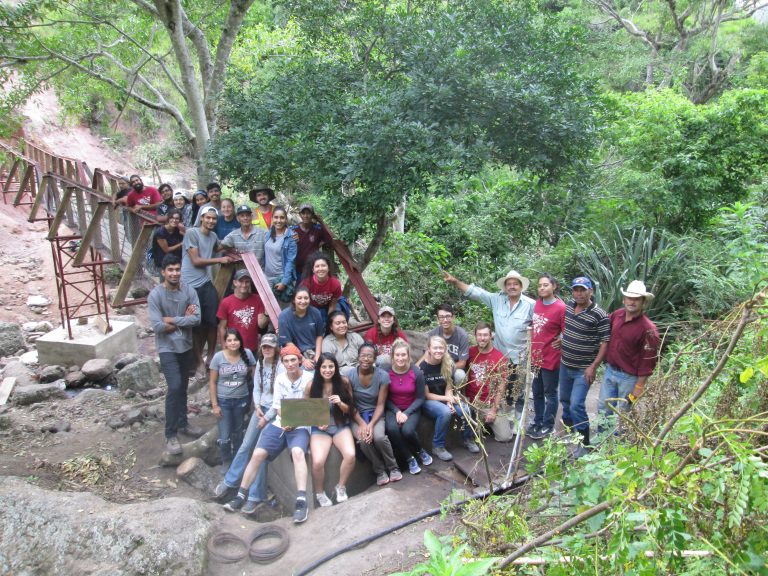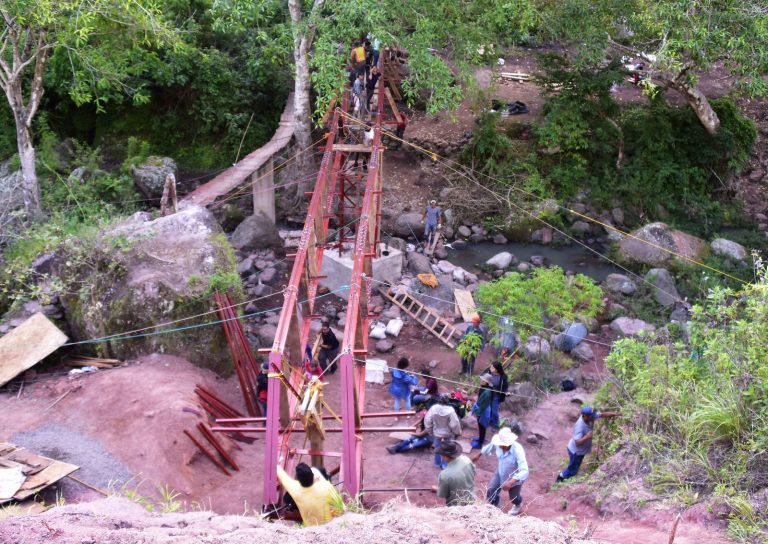By: engr_media
Sunday Feature
Student bridge building project requires more than engineering skills
August 28, 2017
Contact: Sonya Cooper, socooper@nmsu.edu, 575-646-2912
Writer: Linda Fresques, lfresque@nmsu.edu, 575-646-7416
|
|
 |
|
|
Twenty-nine New Mexico State University students spend two weeks constructing and a year of planning and fundraising to complete this 110-foot bridge in Potrero, Nicaragua. (Photo by Norm Arnold) |
|
|
|
Twenty-seven New Mexico State University students and their mentors have just returned from two weeks in Nicaragua where they built a foot bridge spanning 110 feet to provide a small community access over a river that floods during the monsoon season.
The biggest lessons learned by students in Aggies Without Limits (formerly known as Engineering Without Boundaries) were not only about loads, measurements and materials to be considered in bridge design and construction. They gained invaluable life lessons that will change them forever.
“The experience is magical in my mind,” said Associate Dean Sonya Cooper, adviser. “I see these students grow five years over the course of two weeks in terms of their ability to work together, interact and be positive through any negative circumstances. Their emotional character grew in orders of magnitude.”
Co-adviser and Professor Kenny Stevens said, “When you get a group of 20-something students and they realize that there is a big world beyond themselves, something greater than themselves, and they figure out that we need to exist in the world like we are all neighbors—it’s a big thing.”
Aggies Without Limits comprises all student disciplines – this group had students from 11 different majors. The group was formed in 2007 by then student Dorothy Lanphere who has since graduated and works in the power industry. Serving as advisers to the group since its inception are Cooper and Kenny Stevens, both professors of engineering technology.
Victor Meraz, president of AWL, found it difficult to put into words. “How can you explain 27 students from all walks of life and two advisors spending two weeks in another country, sleeping next to each other, working all hours of the day, joking, fighting, making lifelong friends, and becoming a part of another community? This was an unforgettable life experience that we will cherish for the rest of our lives. We sacrificed countless hours for a cause bigger than ourselves, and the reward that came from completing a project that we spent a year working for is unfathomable,” he said.
All of the students traveling to Nicaragua were first-time participants in an AWL international expedition. The group performs an annual international community service project, but also continually work on projects and the surrounding communities. This past year the group has been working on small, sustainable housing for homeless veterans in Alamogordo.
Work for the Nicaragua trip began a year ago, planning, design work and fundraising for the trip – it cost $30 thousand alone in airfare, not to mention materials and supplies. Funds are raised by the students and this year, they were assisted with donations from General Dynamics, Rotary Club Alamogordo, Aggies Go Global and the NMSU Student Foundation. Meraz and Stevens made several advance trips to meet with village people, organize the work and identify what supplies were available locally.
| |
 |
|
Construction of the bridge was completed with few modern conveniences and a lot of backbreaking work. (Photo by Norm Arnold) |
The bridge was constructed in El Potrero, Nicaragua, near the city of La Trinidad, where approximately 100 families make their living farming corn and beans on steep hillsides. They live in huts constructed from bamboo and adobe with hard-pack mud floors. They have no plumbing or paved roads. A new addition of the past year is electricity. During the rainy season, the creek floods and they can’t take their goods to market and the children are unable to attend school in the surrounding communities.
The students slept on the floor of one of the resident’s homes. It rained every day, making the hilly terrain slippery and treacherous.
“We did a great job planning risk management for this project,” said Meraz, “so the problems that did arise, we had a solution for. However, prior to our arrival the community members were instructed to begin digging for foundations and ended up digging too much. We had to make an on-the-field decision to design another steel pier to fix this issue, but thanks to the mentorship of our advisers, it all worked out.”
The NMSU College of Engineering puts a high emphasis on experiential learning, giving students opportunities to do hands-on work and get out of the classroom.
“It might be easier to explain what we didn’t learn or experience since we were exposed to such a broad spectrum of ideas, concepts and procedures. Aside from the overall responsibility of taking on a project of this magnitude and the application of everything we learn in the classroom, we learned: fundraising, networking, project management, leadership, material procurement, take-offs, manufacturing, design work, and bill submittals. The professional experience we gained from this project is unlike any classroom, lab, or homework assignment could ever give us. This is a perfect example of how much experiential based learning can do to students pursuing higher education,” said Meraz.
Professional experience aside, many of the students seemed to know they would learn something much deeper. Mayra Diaz, elementary education major, said prior to the trip, “I think we will learn to appreciate what we take for granted and come back so grateful for what we have.” Luis Garcia, civil engineering student said, “We will get to experience a whole new culture and get to know the community.”
They did not come back disappointed.
Said Meraz, “The best thing all of us took in was respect for all who are not granted the same opportunities as us, but still do anything possible to keep food on the table for those they love. We met with community leaders and elders that told us they would not directly gain from this project, but they were still there every day, working harder than anyone we have ever seen so they could leave a legacy for their children and grandchildren to benefit from.”


